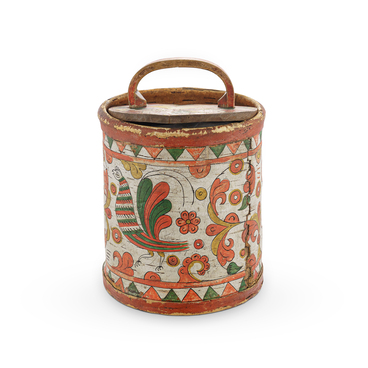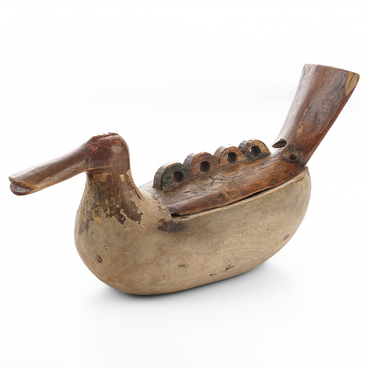Gorodets distaffs were manufactured in the large village of Gorodets, Balakhninsky Uyezd, Nizhny Novgorod Governorate. Wholesale and retail trade in bases for distaffs flourished in the village.
Usually, the upper part of the distaff was covered with decorative patterns and images. This part is called a blade, or a comb. The tow prepared for spinning threads was fixed to the blade, which was clearly visible during the spinning process. Only in Gorodets distaffs, the base was decorated as well. Artists worked on painting the base with great care and love.
Local peasants made the bases for themselves, decorating them with different types of carving patterns: geometric incisions, triangular incisions, nail-like cuts and carved branches. Some were also inlaid with stained oak.
Gradually, from small inserts of stained oak, Gorodets artists moved on to inlaying the entire surface, depicting plot compositions. Due to the complexity of the inlay technique and the commercial nature of the work, there were few such plots. Only three were popular: a carriage, a horseman and a scene with two horsemen on either side of a tree, with a bird flying up from the crown.
The Gorodets base for a distaff, presented in the Museum of Russian Heritage, is a board rounded on one side with a projecting knob (a hoof). The hoof has a hole for attaching a wide blade on a high leg, which was used for spinning. The base is divided into three tiers: the upper one depicts a man on horseback, soldiers with a rifle and saber, a horse, and peacocks. The middle part features four male figures and one female with an umbrella. The lowest section shows two female figures and trees. Along the edge there are a horse and a bird. In some areas, the carved elements are dyed in red and blue. Only Gorodets craftsmen used a very rare technique for Russian folk art — inlay with small pieces of dark stained oak.
Painted bases, made by Gorodets craftsmen, are
distinguished by a detailed composition, which is sometimes even more complex
and colorful than the one on the blade. A distaff base made in Gorodets was the
object of special pride of the owner. After spinning, the woman would hang it
on the wall and, along with lubok pictures, it became an ornament in a
peasant’s house.




